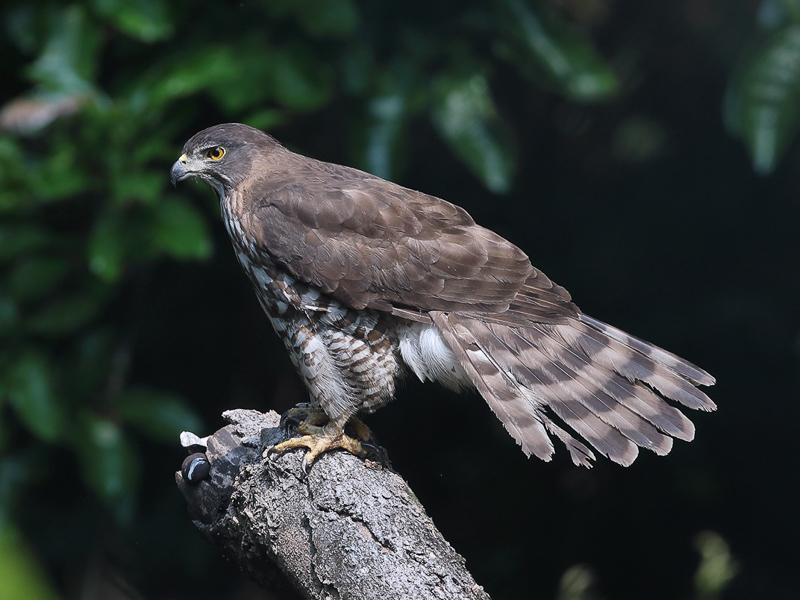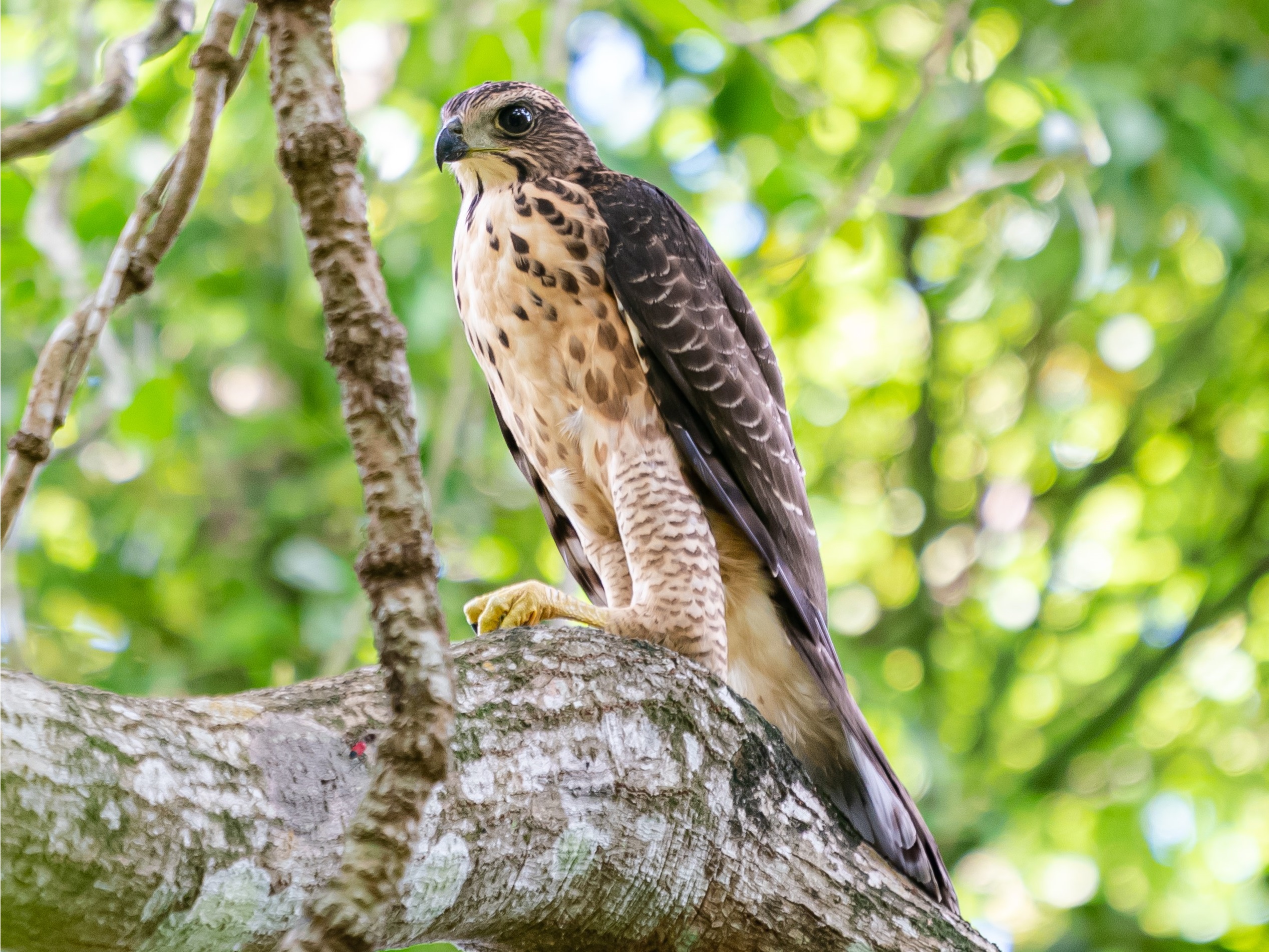Crested Goshawk Lophospiza trivirgata 鳳頭鷹
Category I. Common resident in forest areas, but also hunts in open country.
IDENTIFICATION

May 2008, FUNG Hon Shing.
30-46 cm. The largest accipiter in HK, with the female approximately 10% larger than the male. In flight the rear edges of the relatively long wings are evenly curved over the secondaries and inner primaries, 5-6 primary fingers are visible and the tail appears relatively long and broad with rounded corners. Adults have both streaks and bars on underparts and an obvious dark mesial stripe. Males fluff out the white undertail coverts in display flight.

Apr. 2020, Michelle and Peter Wong.
The plumage of adult males and females is very similar, and they should be together to allow reliable identification to sex. Adults have grey heads (females may have brown nape and crown). Females have less rufous on the chest and are more coarsely marked below; males may have obvious rufous colour across much of chest and contrastingly greyish head. Adults have both eyes and legs orange-yellow to orange, with males tending more to orange. The pale tail bars are equal to or slightly broader than the dark bars. The crest is rarely visible, and the legs and feet are strong compared to other accipiters here.

Jul. 2020, Kenneth Lam.
Juveniles are pale below with broad though usually not dense dark brown streaks on body and underwing coverts, a dark mesial stripe and dense brown barring on thighs. The upperparts are brown with narrow pale fringes to the feathers. The irides are yellow, and the legs greyish to greyish-yellow.
VOCALISATIONS
A shrill ‘he…he…he…hehehehehe’ is uttered by birds in flight, but this is similar to vocalisations uttered by both Besra and Japanese Sparrowhawk, and the differences are uncertain.
Adults utter high-pitched calls either when together or near the nest.
Full-grown juveniles utter a similar ‘hooeet’, inflected for much of its length.
DISTRIBUTION & HABITAT PREFERENCE
Crested Goshawk is widespread, but as a forest specialist it is concentrated in areas of closed-canopy woodland in the northeast New Territories, Tai Mo Shan massif, Ma On Shan, Sai Kung and Lantau. Recorded densities are low, as befits a secretive and high trophic level predator. It can also be seen over shrubland (especially if enriched by fung shui woods), urban parkland and even over marshes in the Deep Bay area.
Based on the breeding and winter atlases, there appears to have been a decline in the range. The percentage of 1km squares in which the species was recorded decreased from 9.6% in the 1993-96 breeding atlas to 3.8% in 2016-19, and from 8.0% in the 2001-05 winter atlas to 5.1% in the 2016-19. On the face of it this is surprising, given the ongoing maturation of shrubland and woodland that is so obvious in many parts of HK. In the New Territories there appears to have been little change in breeding season distribution, rather a decline in the number of 1km squares in which it was recorded. However, on HK Island and, to a lesser extent, Lantau its range appears to have shrunk. In the non-breeding season there appears to be no significant change that could not be due to stochastic factors.
Given the difficulty in identification of sparrowhawks, it is possible that earlier records of Besra were misidentified as Crested Goshawk. This would go some way to explaining the apparent decline in Crested Goshawks, especially on HK Island where Besra is now considered to be most numerous.
OCCURRENCE
Crested Goshawk was first identified at Pok Fu Lam on 19 October 1983 (Chalmers and Viney 1985), and soon afterwards a growing appreciation of its distinctive aerial display flight led to an upsurge of records as birds were identified in the field even on distant views. It was undoubtedly present before this date (probably at least five years prior) but is likely to have colonized only relatively recently given its preference for mature forest.
The lack of historical records from HK and mainland China east of Guangxi (La Touche 1931-34, Cheng 1987) might be taken to indicate that it has since colonised much of southeast China. However, given the extent of deforestation in the region, especially since the 1950s (Smil 1984), a range extension of this scale seems improbable for a forest-dependent species. Instead, it seems more likely that it was simply overlooked or confused with other similar-looking sparrowhawks in the past, due partly to the difficulty of collecting forest raptors and partly to its distinctive display flight not being known.
Birds are reported throughout the year, though it is most obvious when displaying, which occurs in the period September to early June, though mainly February to April. The highest number of full-grown birds reported is four, either two adults and two juveniles, or two displaying pairs. There is no evidence of movements in or out of HK.
BREEDING
Barretto (2017) reported in some detail on the nesting of Crested Goshawk at Tai Po Kau Headland in 2005-09. Three nests were found, all in 30–50-year-old native trees 20-25m in height in north or west-facing woodland. The three nests were made of sticks and placed in a fork in the lower part of the canopy at a height of 12-15m above the ground; one of these was re-built and re-used.
Main events in the breeding cycle were as follows: egg-laying 29 March – 13 May, hatching 11 May – 15 June, fledging 13 June – 13 July, and post-fledging nest dependence to 28 July. Incubation lasted about 33-44 days, fledging was observed at 28-37 days and post-fledging nest dependence lasted up to 45 days. In each year two nestlings were noted, with the male becoming independent of the nest and leaving the nesting area earlier than females.
Nests have also been recorded in Acacia confusa in parkland at the urban edge of Tuen Mun. Females may show aggressive behaviour toward those making a close approach to the nest.
BEHAVIOUR, FORAGING & DIET
Prey items recorded include squirrels, rodents, bats, snakes and birds, species identified being Band-bellied Squirrel Callosciurus flavimanus (Phillipps 1989), Feral Dove, Spotted Dove, Collared Scops Owl, Asian Barred Owlet, Mountain Bulbul, Chestnut Bulbul, Chinese Francolin, Little Swift, Silver-eared Mesia and Eurasian Tree Sparrow. The attempted predation of Chinese Pond Herons has twice been reported.
Generally difficult to see in its preferred habitat of dense woodland, Crested Goshawk is more usually seen in display, when the extensive and fluffed up white undertail coverts are very obvious, and the wings are held slightly down and fluttered or rapidly flapped.
RANGE & SYSTEMATICS
Occurs from east India, Sri Lanka and the Himalayas east through northeast India and Myanmar to Indochina and south China including Taiwan, and south through Malaysia to Indonesia and the southern Philippines (Clark and Marks 2020). In China it is widespread in the southern half of the country from southeast Tibet to Shandong (Liu and Chen 2021).
L. t. indicus occurs from northeast India to Indochina, the Malay peninsula and south China including HK. Ten other subspecies are also recognised, mainly island forms in Indonesia and the Philippines.
CONSERVATION STATUS
IUCN: Least Concern. Population decreasing.
Barretto, R. (2017). Nesting of Crested Goshawk Accipiter trivirgatus at Tai Po Kau Headland Conservation Area, Hong Kong. Hong Kong Bird Report 2015: 360-368.
Chalmers, M. L. and C. A. Viney (1985). Systematic List 1983. Hong Kong Bird Report 1983: 6-36.
Cheng, T. H. (1987). A Synopsis of the Avifauna of China. Science Press, Beijing.
Clark, W. S. and J. S. Marks (2020). Crested Goshawk (Accipiter trivirgatus), version 1.0. In Birds of the World (J. del Hoyo, A. Elliott, J. Sargatal, D. A. Christie, and E. de Juana, Editors). Cornell Lab of Ornithology, Ithaca, NY, USA. https://doi.org/10.2173/bow.cregos1.01
La Touche, J. D. D. (1931-34). Handbook of the birds of Eastern China Vol. 2. Taylor and Francis, London.
Liu, Y. and S. H. Chen (eds) (2021). The CNG Field Guide to the Birds of China (in Chinese). Hunan Science and Technology Publication House, Changsha.
Phillipps, K. (1989). Crested Goshawk preying on Band-bellied Squirrel. Hong Kong Bird Report 1988: 115.
Smil, V. (1984). The Bad Earth: Environmental Degradation in China. Zed Press, London.

